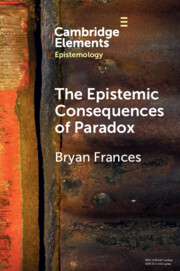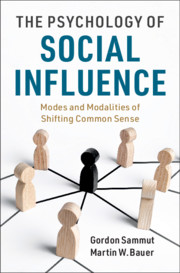33 results
2 - The Reasonable Person in Birmingham
-
- Book:
- The Reasonable Person
- Published online:
- 30 May 2024
- Print publication:
- 06 June 2024, pp 33-58
-
- Chapter
- Export citation
Chapter 15 - Contested Concepts
-
-
- Book:
- Conceptualising Concepts in Greek Philosophy
- Published online:
- 25 April 2024
- Print publication:
- 02 May 2024, pp 345-367
-
- Chapter
- Export citation
4 - Prudence
- from PART IV - THE ETHOS OF MODERATION
-
- Book:
- Why Not Moderation?
- Published online:
- 12 October 2023
- Print publication:
- 12 October 2023, pp 175-182
-
- Chapter
- Export citation
2 - Modesty and Humility
- from PART IV - THE ETHOS OF MODERATION
-
- Book:
- Why Not Moderation?
- Published online:
- 12 October 2023
- Print publication:
- 12 October 2023, pp 160-167
-
- Chapter
- Export citation
Chapter 7 - Social Representations and Common Sense
- from Part II - The Dialogical Perspective of the Theory of Social Representations and Communication
-
- Book:
- The Making of a Dialogical Theory
- Published online:
- 22 June 2023
- Print publication:
- 06 July 2023, pp 153-177
-
- Chapter
- Export citation
Chapter 4 - Nos in diem vivimus
- from Part I - Techniques and Tactics of Ciceronian Philosophy
-
-
- Book:
- Power and Persuasion in Cicero's Philosophy
- Published online:
- 15 January 2023
- Print publication:
- 05 January 2023, pp 77-96
-
- Chapter
- Export citation
9 - Mental Passivity: The British Tradition
- from Part I - Psychology’s Historical Foundations
-
- Book:
- History and Systems of Psychology
- Published online:
- 04 November 2022
- Print publication:
- 17 November 2022, pp 164-183
-
- Chapter
- Export citation
Chapter One - The First Sketch
-
- Book:
- Fundamental Principles of Corpus Linguistics
- Published online:
- 22 September 2022
- Print publication:
- 29 September 2022, pp 3-28
-
- Chapter
- Export citation

The Epistemic Consequences of Paradox
-
- Published online:
- 30 June 2022
- Print publication:
- 28 July 2022
-
- Element
- Export citation
1 - Evidence as a Multidisciplinary Field
- from Part I - Evidence As an Area of Knowledge
-
-
- Book:
- Evidential Legal Reasoning
- Published online:
- 05 May 2022
- Print publication:
- 19 May 2022, pp 13-33
-
- Chapter
- Export citation
Chapter 5 - The Significance of Form and the Aesthetic Purposiveness of Nature
-
- Book:
- Kant and the Claims of the Empirical World
- Published online:
- 30 April 2022
- Print publication:
- 28 April 2022, pp 138-199
-
- Chapter
- Export citation
Kant on Common Sense and Empirical Concepts
-
- Journal:
- Kantian Review / Volume 27 / Issue 2 / June 2022
- Published online by Cambridge University Press:
- 14 March 2022, pp. 257-277
- Print publication:
- June 2022
-
- Article
-
- You have access
- Open access
- HTML
- Export citation
Chapter 9 - Perceptual Attention and Reflective Awareness in the Aristotelian Tradition
-
-
- Book:
- Aristotle's On the Soul
- Published online:
- 06 January 2022
- Print publication:
- 20 January 2022, pp 174-194
-
- Chapter
- Export citation
4 - Common Sense Commons
-
-
- Book:
- Governing Markets as Knowledge Commons
- Published online:
- 09 December 2021
- Print publication:
- 16 December 2021, pp 113-132
-
- Chapter
- Export citation
Chapter 9 - Knowledge through Interpretation (2)
-
- Book:
- The Epistemology of Reading and Interpretation
- Published online:
- 03 September 2021
- Print publication:
- 16 September 2021, pp 208-233
-
- Chapter
- Export citation
Chapter 4 - Modes of Attunement
-
- Book:
- Kant's Critique of Taste
- Published online:
- 07 April 2021
- Print publication:
- 15 April 2021, pp 137-167
-
- Chapter
- Export citation
Chapter 8 - Agenda Setting, Framing and Mass Mediation
- from Part III - Necessary Extensions
-
- Book:
- The Psychology of Social Influence
- Published online:
- 19 December 2020
- Print publication:
- 07 January 2021, pp 163-187
-
- Chapter
- Export citation
Chapter 4 - Norming and Framing
- from Part II - Experimental Paradigms
-
- Book:
- The Psychology of Social Influence
- Published online:
- 19 December 2020
- Print publication:
- 07 January 2021, pp 77-96
-
- Chapter
- Export citation

The Psychology of Social Influence
- Modes and Modalities of Shifting Common Sense
-
- Published online:
- 19 December 2020
- Print publication:
- 07 January 2021
9 - The Problem of the Criterion
-
- Book:
- An Introduction to the Theory of Knowledge
- Published online:
- 11 November 2020
- Print publication:
- 26 November 2020, pp 177-197
-
- Chapter
- Export citation



